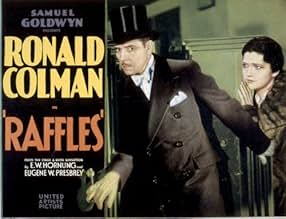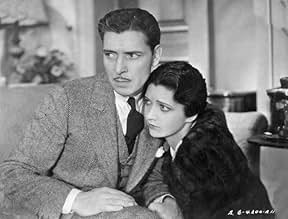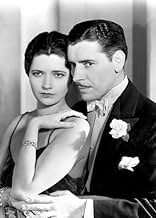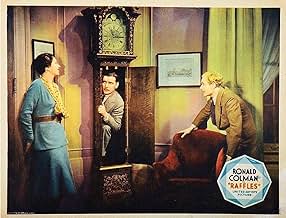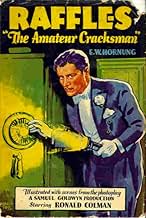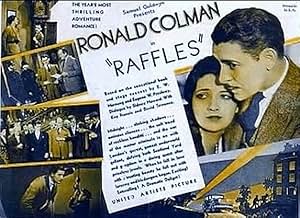A distinguished English gentleman has a secret life--he is the notorious jewel thief the press has dubbed "The Amateur Cracksman". When he meets a woman and falls in love he decides to "reti... Read allA distinguished English gentleman has a secret life--he is the notorious jewel thief the press has dubbed "The Amateur Cracksman". When he meets a woman and falls in love he decides to "retire" from that life, but an old friend comes to him with a predicament that entails him com... Read allA distinguished English gentleman has a secret life--he is the notorious jewel thief the press has dubbed "The Amateur Cracksman". When he meets a woman and falls in love he decides to "retire" from that life, but an old friend comes to him with a predicament that entails him committing one last job.
- Directors
- Writers
- Stars
- Nominated for 1 Oscar
- 2 wins & 1 nomination total
- Lord Harry Melrose
- (as Frederic Kerr)
- Lord Melrose's Butler
- (uncredited)
- Harry - Lord & Lady Melrose's Friend
- (uncredited)
- Gwen's Friend
- (uncredited)
- Party Guest
- (uncredited)
- Directors
- Writers
- All cast & crew
- Production, box office & more at IMDbPro
Featured reviews
Ah, but it stars 'The Voice', Ronald Colman, and that makes all the difference. Colman and his mellifluous voice glide through every scene and anesthetizes an unbelievable story just by talking. Here he was at the height of his popularity as the dashing cricketer/thief and has as his leading lady Kay Francis, one of the loveliest stars of that era. She is unfortunately given little to do in a meager role as his fiancé. But there are some other Hollywood stalwarts in the cast, among them Alison Skipworth in one of her ditzy socialite roles and silent film bad guy David Torrence, a Scotsman with a thick Scottish accent, as the investigating detective. Also Bramwell Fletcher and Frederick Kerr, a very elderly gentleman I found delightful in "Waterloo Bridge (1930)" in the same blustery, old duffer-type role.
"Raffles" is uncomplicated and good fun, and about as deep as a dish of water, but worth your time to see and hear Colman say things - doesn't matter what, just listen to him talk. Thank TCM for dusting this one off.
In the 1939 version, maybe because of the code, Raffles is a Robin Hood type who robs for the excitement and fun of it but then helps someone in need with the money or returns the merchandise. In this version, he steals, period, and in fact presents Gwen with a bracelet from one of his crimes. This film skips the whole beginning of the '39 film showing Raffles' acts of kindness, but the rest of the story is the same. Raffles decides to retire and start life anew with Gwen, but his friend Bunny shows up with a gambling problem and needs to cover a 1000 pound check by Monday. Raffles, alas, needs to do one more job.
Ronald Colman is delightful as Raffles, dashing, charming, and handsome as he cleverly attempts to escape the clutches of Scotland Yard. It's a wonderful role for him, as it was for David Niven in 1939. Kay Francis is wasted but is a good match for Coleman.
Fun film with a fine performance by Colman.
Moreover, as another character chimes, one, indeed, can't help liking Colman's Raffles. The supporting cast is decent, too, including Kay Francis as the romantic interest, David Torrence as the Scottish Scotland Yard inspector, and Alison Shipworth and Frederick Kerr are amusing as the bickering hosts to their home of guests spending the weekend, apparently, smoking, drinking and playing cricket and tennis--the sort of upper-class soirées one might expect from an episode of "Downton Abbey," where dandies in tuxedos sip brandy and retort that Americans are too savage to understand cricket.
I think what raises "Raffles" above many other early talkies, however, is the talent Samuel Goldwyn assembled behind the scenes, namely cinematographers George Barnes (5-time Oscar nominee) and Gregg Toland (who also photographed the 1939 version and is most famous for "Citizen Kane" (1941)) and art directors Park French and William Cameron Menzies (the latter of whom would invent the job of production designer during the making of "Gone with the Wind" (1939)). There's nothing amateurish in their design of the amateur cracksman's first heist scene, with the policeman's shadow lurking in the background behind store-front glass as a safe is cracked with the aid of a diegetic light source. Some camera movement is managed, too, including a nice shot of Colman on the staircase upon seeing Francis's entry. Being England, there's also a fog-filled sequence. There's nothing amazing about any of this, but it's worth noting how much difference to a slight scenario burdened by primitive new technology can benefit from skilled artists behind the camera while placing charming actors in front of it, as well as giving some thought to how to use and not use the newfangled sound.
I'm a great fan of the Raffles books. E W Hornung the author was not so well known as his brother in law, Arthur Conan-Doyle but was though alround a better writer. This film is engaging and quite exciting, brings together parts from different stories and the result is entertaining but in terms of story, thin and slap-dash. The adaptation is dominated by the requirement to continue/assist Ronald Colman's highly bankable screen persona as an elegant, humorous, charming pleaser of ladies.(Raffles in the book is too dedicated to be humorous or charming unless necessary in pursuit of crime). Here Raffles love interest, Kay Francis, is very passionate, unlimited in her devotion to him. Of the two other central characters, companion in crime "Bunny" Manders is reduced to an irrelevance. Curiously the third character in the trio - McKenzie, the "Scotch" detective - alone is the all-time definitive rendering of the character in the book - Raffles' feared Nemesis: dogged, doughty and determined. Indeed the adaptation gives him equal billing with his quarry. It's a joy to watch a character from the books so vividly and truthfully brought to life. Clearly whoever did the adaptation was more interested in and relished McKenzie more than the other two.
All in all, a good entertainment.
The Raffles stories were extremely popular and have been the subject of many film, theater, and television treatments. One of the best of these is this 1930, very early talkie starring cinema's quintessential English gentleman, Ronald Coleman. It's really quite a good film for its time, with an intelligent script, generally good acting (especially by Coleman and character actor Frederick Kerr, better known as Baron Frankenstein in James Whale's famous 1931 treatment of the monster story, who steals every scene he is in as a grouchy English lord.) Co-cinematographer Gregg Toland, who later worked on many Hollywood classics, is presumably responsible for the film's noirish, atmospheric lighting effects.
All in all, I'd say this entertaining film will still be enjoyed by today's audiences, and is a must see for fans of Coleman.
Did you know
- TriviaThe last Samuel Goldwyn movie to be shot simultaneously in silent and talkie versions.
- GoofsWhen the alarm goes off and the cat burglar is attempting to escape, Bunny's bedroom windows are show to be wide open, which would have prevented the alarm being set in the first place.
- Quotes
Inspector McKenzie: Good heavens! In the tobacco! Well, I'll be...
A.J. Raffles: Yes, I thought that you would be.
- Alternate versionsRaffles, gentleman cambrioleur (1930) was made simultaneously in silent and talking versions. With almost all the theaters in the USA wired for sound, this was to be the last film that Samuel Goldwyn produced in this manner.
- ConnectionsReferenced in Au seuil de la vie (1936)
- SoundtracksThe Blue Danube
(uncredited)
Written by Johann Strauss
Heard when Raffles takes Lady Melrose to her room.
- How long is Raffles?Powered by Alexa
Details
Box office
- Gross US & Canada
- $1,000,000
- Runtime
- 1h 12m(72 min)
- Color
- Sound mix
- Aspect ratio
- 1.20 : 1

